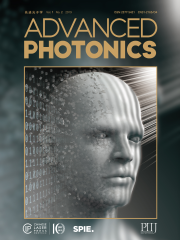 View fulltext
View fulltext
Continued support for research and investment in photonics requires that the public and policy makers are made aware of its significance for societal development. All of us have a role to play in promoting the importance of our field.
A fast off-axis scanning subvoxel light-sheet microscope enables high-throughput image large-volume specimens at cellular resolution.
Phonon-polaritons offer an exciting avenue in nanophotonics. We comment on the novel nanofabrication approach presented by Bo Qiang et al. in this issue of Advanced Photonics. Their approach to phononic material allows better radiation manipulation, and high Q-factors.
Usually, an unfocused light beam, such as a paraxial Gaussian beam, can exert a force on an object along the direction of light propagation, which is known as light pressure. Recently, however, it was found that an unfocused light beam can also exert an optical pulling force (OPF) on an object toward the source direction; the beam is accordingly named an optical tractor beam. In recent years, this intriguing force has attracted much attention and a huge amount of progress has been made both in theory and experiment. We briefly review recent progress achieved on this topic. We classify the mechanisms to achieve an OPF into four different kinds according to the dominant factors. The first one is tailoring the incident beam. The second one is engineering the object’s optical parameters. The third one is designing the structured material background, in which the light–matter interaction occurs, and the fourth one is utilizing the indirect photophoretic force, which is related to the thermal effect of light absorption. For all the methods, we analyze the basic principles and review the recent achievements. Finally, we also give a brief conclusion and an outlook on the future development of this field.
Free from phase-matching constraints, plasmonic metasurfaces have contributed significantly to the control of optical nonlinearity and enhancement of nonlinear generation efficiency by engineering subwavelength meta-atoms. However, high dissipative losses and inevitable thermal heating limit their applicability in nonlinear nanophotonics. All-dielectric metasurfaces, supporting both electric and magnetic Mie-type resonances in their nanostructures, have appeared as a promising alternative to nonlinear plasmonics. High-index dielectric nanostructures, allowing additional magnetic resonances, can induce magnetic nonlinear effects, which, along with electric nonlinearities, increase the nonlinear conversion efficiency. In addition, low dissipative losses and high damage thresholds provide an extra degree of freedom for operating at high pump intensities, resulting in a considerable enhancement of the nonlinear processes. We discuss the current state of the art in the intensely developing area of all-dielectric nonlinear nanostructures and metasurfaces, including the role of Mie modes, Fano resonances, and anapole moments for harmonic generation, wave mixing, and ultrafast optical switching. Furthermore, we review the recent progress in the nonlinear phase and wavefront control using all-dielectric metasurfaces. We discuss techniques to realize all-dielectric metasurfaces for multifunctional applications and generation of second-order nonlinear processes from complementary metal–oxide–semiconductor-compatible materials.
In many optical metrology techniques, fringe pattern analysis is the central algorithm for recovering the underlying phase distribution from the recorded fringe patterns. Despite extensive research efforts for decades, how to extract the desired phase information, with the highest possible accuracy, from the minimum number of fringe patterns remains one of the most challenging open problems. Inspired by recent successes of deep learning techniques for computer vision and other applications, we demonstrate for the first time, to our knowledge, that the deep neural networks can be trained to perform fringe analysis, which substantially enhances the accuracy of phase demodulation from a single fringe pattern. The effectiveness of the proposed method is experimentally verified using carrier fringe patterns under the scenario of fringe projection profilometry. Experimental results demonstrate its superior performance, in terms of high accuracy and edge-preserving, over two representative single-frame techniques: Fourier transform profilometry and windowed Fourier transform profilometry.
Phonon polariton resonances in the mid-infrared spectral range demonstrate properties superior to noble metal-based plasmonics, owing to smaller dissipative loss and better field confinement. However, a conventional way to excite the localized phonon resonance involves ion etching, which reduces the attainable quality factors (Q-factors) of the resonators. We show that by introducing a deep subwavelength layer of dielectric gratings on a phononic substrate, localized dipolar resonance and higher order modes with high Q-factors 96 and 195, respectively, can be excited. We further demonstrate, via experiments and simulations, that the resonant wavelength and field confinement can be controlled by coupling the localized hybrid mode with propagating surface phonon-polaritons. We also observed for the first time the coupling between a localized dipolar mode and a propagating higher-order surface phonon-polariton mode. The results will be useful in designing on-chip, low-loss, and highly integrated phononic devices in the infrared spectral domain.














